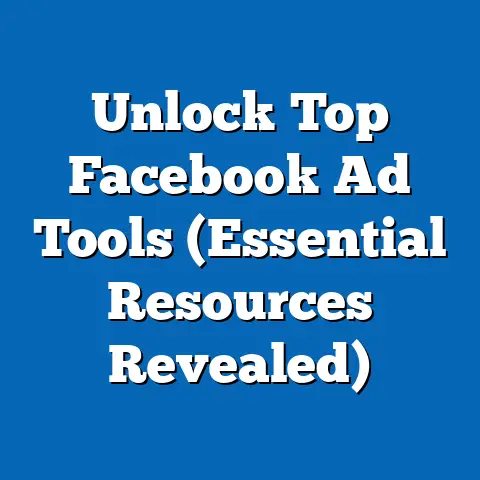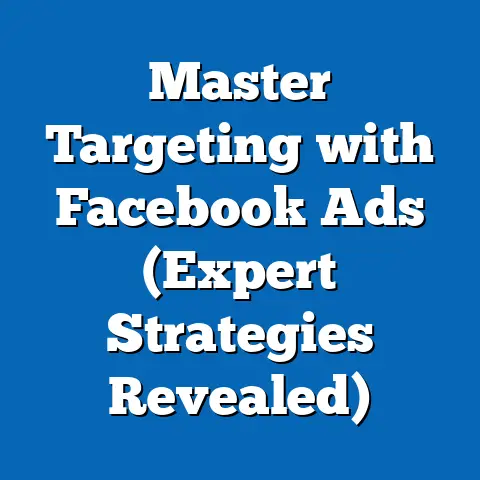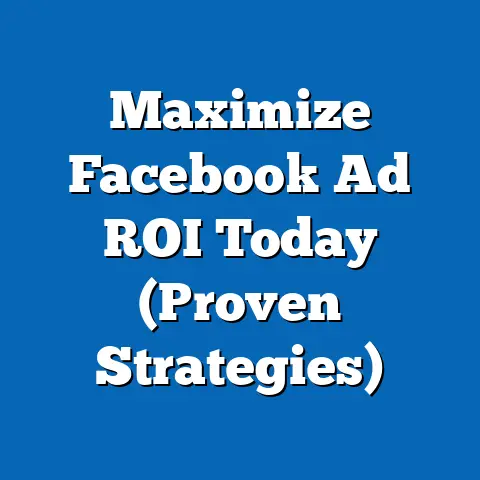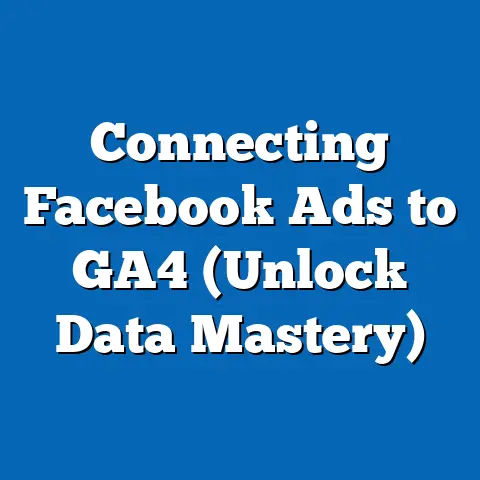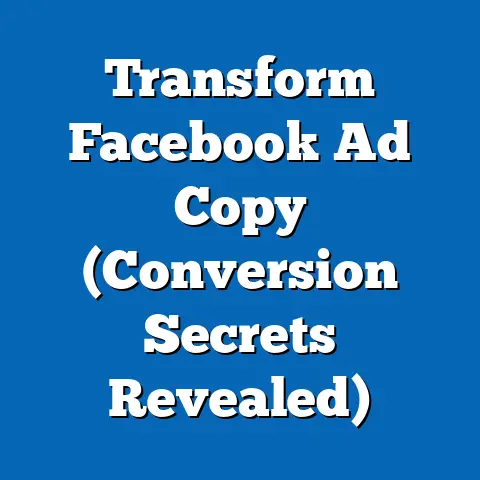Optimize Language Settings in Facebook Ads (Expert Tips)
Imagine this: You’ve poured your heart and soul into creating the perfect product. You know it solves a real problem, and you’re excited to share it with the world. You craft a brilliant Facebook ad, complete with stunning visuals and compelling copy. You launch your campaign, eager to see the results… but the results are underwhelming. Clicks are low, conversions are even lower. What went wrong?
It’s possible your ad is great, but it’s simply not resonating with your target audience because of one overlooked factor: language. What if your ads could speak directly to each viewer in their preferred language? Imagine the impact of instantly connecting with potential customers on a personal level, boosting engagement, click-through rates, and ultimately, sales.
This is the power of optimizing language settings in Facebook Ads. In today’s increasingly globalized world, where multilingualism is the norm, mastering language settings can be the key to unlocking unprecedented advertising success. As someone who’s managed countless Facebook ad campaigns, I’ve seen firsthand the dramatic difference that language optimization can make. I’ve seen campaigns go from struggling to thriving simply by tailoring the language to the target audience.
1. Understanding Facebook’s Language Settings
Before we get into the “how,” let’s understand the “why.” Why is language so important in advertising, and what options does Facebook offer?
1.1 Overview of Language Options
Facebook offers a vast array of language options for your ads, far beyond just the major languages like English, Spanish, and French. You can target specific regional dialects and language variations. For example, you can target users who speak “British English” separately from those who speak “American English.” This level of granularity allows you to fine-tune your messaging and ensure it resonates with your audience.
The key takeaway here is that Facebook recognizes the nuances within languages. It’s not just about translating your ad; it’s about speaking your audience’s language.
Significance of Selecting the Right Language:
Choosing the right language is paramount because it directly impacts your ad’s relevance and effectiveness. If you’re selling a product specifically designed for the French market, targeting users who speak English will likely result in wasted ad spend and low engagement.
Think of it this way: you wouldn’t try to sell snow shovels in the Sahara Desert, would you? Similarly, you shouldn’t serve ads in the wrong language to your target audience.
1.2 Why Language Matters in Advertising
Language is much more than just a means of communication; it’s deeply intertwined with culture, identity, and emotions. When you speak to someone in their native language, you’re not just conveying information; you’re building a connection.
Psychological Effects of Language:
Studies have shown that consumers are more likely to trust and engage with brands that communicate with them in their native language. This is because language evokes a sense of familiarity, comfort, and understanding. It signals that the brand cares about them and values their culture.
Statistics and Case Studies:
- A study by Common Sense Advisory found that 75% of consumers are more likely to purchase a product if the product information is available in their own language.
- A Harvard Business Review article highlighted a case study where a company saw a 25% increase in conversion rates after localizing its website into multiple languages.
In my own experience, I’ve seen similar results. I worked with a client who sold high-end watches. Initially, their Facebook ads were only in English. After translating and localizing their ads into Spanish and Mandarin, they saw a significant boost in sales from those markets. The key was not just translating the words but adapting the messaging to resonate with the cultural values and preferences of those audiences.
Key Takeaway: Language is a powerful tool that can significantly impact consumer behavior. By tailoring your ads to specific languages, you can increase engagement, build trust, and ultimately, drive conversions.
2. Setting Up Language Targeting in Facebook Ads
Now that we understand the importance of language, let’s get practical. How do you actually set up language targeting in Facebook Ads Manager?
2.1 Step-by-Step Guide to Language Targeting
Here’s a detailed walkthrough of how to access and select language settings in Facebook Ads Manager:
- Create a New Campaign or Ad Set: Start by creating a new campaign or ad set in Facebook Ads Manager. You can also edit an existing ad set.
- Navigate to Audience Targeting: Within your ad set settings, scroll down to the “Audience” section.
- Detailed Targeting: Look for the “Detailed Targeting” section. This is where you define your audience based on interests, demographics, and behaviors.
- Languages: Below the “Detailed Targeting” box, you’ll see a section labeled “Languages.” Click on the “Edit” button.
- Select Languages: A pop-up window will appear, allowing you to search for and select the languages you want to target. You can add multiple languages to a single ad set.
- Save Your Settings: Once you’ve selected your desired languages, click “Close” to save your settings.
Visual Aids:
(Ideally, this section would include screenshots of each step in the Facebook Ads Manager interface.)
Important Note: Facebook targets users based on the language they’ve selected as their preferred language on their Facebook profile. This is generally a reliable indicator of their primary language.
2.2 Targeting Multiple Languages
What if your business caters to a multilingual audience? How do you effectively reach them without creating a confusing or disjointed ad experience?
Strategies for Multilingual Audiences:
- Separate Ad Sets: The most effective approach is to create separate ad sets for each language you want to target. This allows you to tailor your ad copy, visuals, and landing page to each specific language.
- Dynamic Language Optimization (DLO): Facebook’s DLO feature automatically shows the most relevant language version of your ad to each user based on their preferred language settings. We’ll delve deeper into DLO in a later section.
- Language-Specific Landing Pages: Ensure that your landing page matches the language of your ad. Sending users to a landing page in a different language will create a jarring experience and likely lead to high bounce rates.
Maintaining Brand Consistency:
While it’s important to tailor your ads to each language, you also need to maintain brand consistency. This means using the same brand colors, logo, and overall tone across all your ads, regardless of the language.
One way to achieve this is to create a style guide that outlines your brand’s visual and verbal identity. This guide should be shared with all translators and copywriters to ensure that they adhere to your brand standards.
My Personal Experience:
I once worked with a client who was launching a new product in Europe. They wanted to target users in France, Germany, and Spain. Initially, they created a single ad set with ads in English. The results were underwhelming.
We decided to create separate ad sets for each language, with ads that were not only translated but also localized to reflect the cultural nuances of each country. We also created language-specific landing pages. The results were dramatic. We saw a significant increase in engagement, click-through rates, and conversions.
Key Takeaway: When targeting multilingual audiences, creating separate ad sets for each language is the most effective approach. This allows you to tailor your ads and landing pages to each specific language, while still maintaining brand consistency.
3. Crafting Compelling Copy for Different Languages
Translation is not enough. To truly resonate with your audience, you need to localize your ad copy.
3.1 Translating vs. Localizing
Translation:
Translation is the process of converting text from one language to another while maintaining its literal meaning. While translation is a necessary first step, it’s often not enough to create truly effective ad copy.
Localization:
Localization goes beyond translation. It’s the process of adapting your ad copy to the cultural nuances, values, and preferences of your target audience. This includes adapting the tone, style, and messaging to resonate with the specific cultural context.
Examples of Localization:
- Using Local Idioms and Slang: Instead of using a direct translation, use idioms and slang that are commonly used in the target language.
- Adapting Humor: Humor is highly cultural. What’s funny in one culture may not be funny in another. Adapt your humor to resonate with the specific cultural context.
- Adjusting Images and Visuals: Use images and visuals that are relevant and appealing to your target audience. Avoid using images that may be offensive or culturally insensitive.
My Experience with Localization:
I remember working on a campaign for a travel company that wanted to target users in Japan. Initially, they simply translated their English ads into Japanese. The results were disappointing. The ads felt generic and didn’t resonate with the Japanese audience.
We decided to work with a local copywriter who understood the nuances of Japanese culture. The copywriter completely rewrote the ads, using a more polite and respectful tone. They also incorporated images of popular Japanese tourist destinations. The results were remarkable. We saw a significant increase in engagement and bookings from Japan.
Key Takeaway: Localization is essential for creating truly effective ad copy. It goes beyond translation and adapts your messaging to the cultural nuances, values, and preferences of your target audience.
3.2 Best Practices for Writing in Multiple Languages
Here are some expert tips for creating engaging ad copy that resonates with diverse audiences:
- Hire Native Speakers: Work with native speakers who have a deep understanding of the target language and culture.
- Provide Context: Give your translators and copywriters as much context as possible about your product, target audience, and campaign goals.
- Review and Edit: Always have your translated and localized ad copy reviewed and edited by a second native speaker.
- Test and Iterate: A/B test different versions of your ad copy to see what resonates best with your audience.
- Be Mindful of Tone: Adjust your tone to match the cultural context. Some cultures prefer a more formal tone, while others prefer a more casual tone.
- Avoid Cultural Stereotypes: Be careful to avoid using cultural stereotypes that may be offensive or inaccurate.
- Use Inclusive Language: Use language that is inclusive and respectful of all cultures and identities.
Cultural Nuances and Tone Adjustments:
Understanding cultural nuances is crucial for effective communication. For example, in some cultures, directness is valued, while in others, indirectness is preferred. Similarly, some cultures are more comfortable with humor than others.
Key Takeaway: By following these best practices, you can create engaging ad copy that resonates with diverse audiences and drives results.
4. Testing and Analyzing Language Performance
You’ve set up your language targeting and crafted compelling ad copy. Now it’s time to test and analyze your results.
4.1 Setting Up A/B Tests for Language Variations
A/B testing is a powerful tool for measuring the effectiveness of different language settings. Here’s how to set up A/B tests for language variations:
- Create a Duplicate Ad Set: Start by creating a duplicate of your existing ad set.
- Modify Language Settings: In the duplicate ad set, modify the language settings to target a different language.
- Run the Tests: Run both ad sets simultaneously and track their performance.
- Analyze the Results: After a sufficient period of time, analyze the results to see which language setting performed better.
Key Metrics to Monitor:
- Click-Through Rate (CTR): Measures the percentage of people who saw your ad and clicked on it.
- Conversion Rate: Measures the percentage of people who clicked on your ad and completed a desired action, such as making a purchase or filling out a form.
- Cost Per Click (CPC): Measures the average cost you pay each time someone clicks on your ad.
- Cost Per Conversion (CPC): Measures the average cost you pay for each conversion.
- Return on Ad Spend (ROAS): Measures the revenue you generate for every dollar you spend on advertising.
My A/B Testing Success:
I once ran an A/B test for a client who sold online courses. We tested two different language settings: English and Spanish. The results were clear: the Spanish ads had a significantly higher CTR and conversion rate than the English ads. This led us to focus our efforts on the Spanish market, which resulted in a significant increase in sales.
Key Takeaway: A/B testing is essential for measuring the effectiveness of different language settings. By monitoring key metrics, you can identify which language settings are performing best and optimize your campaigns accordingly.
4.2 Analyzing Results and Making Data-Driven Decisions
Once you’ve collected data from your A/B tests, it’s time to analyze the results and make data-driven decisions.
Interpreting Ad Performance Reports:
Facebook Ads Manager provides detailed ad performance reports that you can use to analyze your results. These reports include data on impressions, clicks, conversions, cost per click, and cost per conversion.
Adjusting Language Strategies Based on Analytical Findings:
Based on your analytical findings, you can adjust your language strategies to improve your campaign performance. For example, if you find that a particular language setting is not performing well, you can pause that ad set and focus your efforts on the language settings that are performing better.
Key Takeaway: Analyzing your ad performance data is essential for making data-driven decisions and optimizing your language strategies.
5. Advanced Language Optimization Techniques
Now that you’ve mastered the basics, let’s explore some advanced language optimization techniques.
5.1 Utilizing Dynamic Language Optimization
Facebook’s Dynamic Language Optimization (DLO) is a powerful feature that automatically shows the most relevant language version of your ad to each user based on their preferred language settings.
How DLO Works:
With DLO, you create multiple versions of your ad in different languages. Facebook then uses its algorithm to determine which version of the ad is most relevant to each user based on their preferred language settings.
Benefits of DLO:
- Increased Relevance: DLO ensures that your ads are always relevant to your target audience.
- Improved Engagement: By showing users ads in their preferred language, you can increase engagement and click-through rates.
- Simplified Campaign Management: DLO simplifies campaign management by allowing you to create a single ad campaign that targets multiple languages.
Implementing DLO:
To implement DLO, you need to create multiple versions of your ad in different languages and upload them to Facebook Ads Manager. Facebook will then automatically show the most relevant version of the ad to each user.
My DLO Success Story:
I used DLO for a client who was selling software to businesses in Europe. We created ads in English, French, German, and Spanish. DLO automatically showed the most relevant version of the ad to each user based on their preferred language settings. As a result, we saw a significant increase in engagement and leads.
Key Takeaway: DLO is a powerful feature that can help you increase the relevance of your ads, improve engagement, and simplify campaign management.
5.2 Leveraging User-Generated Content in Multiple Languages
User-generated content (UGC) is any content that is created by users, rather than by the brand itself. This can include reviews, testimonials, photos, and videos.
Value of UGC in Multiple Languages:
UGC can be a powerful tool for building trust and credibility among diverse linguistic groups. When potential customers see that other people who speak their language are using and recommending your product, they are more likely to trust your brand.
Examples of UGC:
- Customer Reviews: Collect customer reviews in different languages and display them on your website and in your ads.
- Testimonials: Feature testimonials from customers who speak different languages.
- Photos and Videos: Encourage customers to share photos and videos of themselves using your product.
Enhancing Authenticity and Trust:
UGC is seen as more authentic and trustworthy than traditional advertising. This is because it comes from real people, rather than from the brand itself.
Key Takeaway: Leveraging UGC in multiple languages can help you build trust and credibility among diverse linguistic groups.
Conclusion: The Future of Language in Facebook Advertising
Optimizing language settings in Facebook Ads is no longer a nice-to-have; it’s a necessity. In a world that’s becoming increasingly interconnected and multilingual, speaking your audience’s language is the key to unlocking unprecedented advertising success.
I hope this guide has provided you with the knowledge and tools you need to create truly effective multilingual campaigns. Remember, language is not just a barrier; it’s a bridge. It’s a bridge that can connect you with your audience on a deeper level, build trust, and drive conversions.
As businesses continue to embrace multilingualism, the potential for growth and engagement in Facebook advertising is limitless. So, embrace the power of language and unlock the full potential of your Facebook ad campaigns.
Next Steps:
- Review your current Facebook ad campaigns and identify opportunities to optimize your language settings.
- Start A/B testing different language variations to see what resonates best with your audience.
- Explore Facebook’s Dynamic Language Optimization feature.
- Start collecting user-generated content in multiple languages.
By taking these steps, you can start to see the transformative power of language optimization in your Facebook ad campaigns. Good luck!

